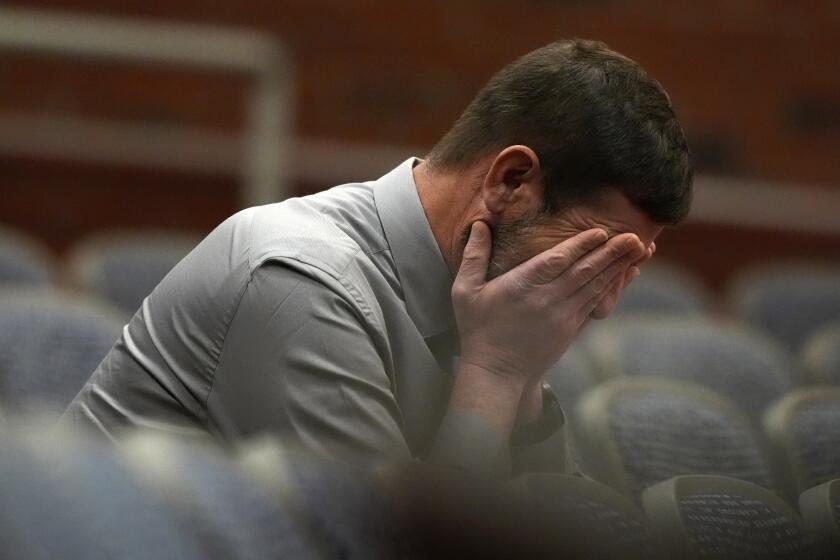Anxiety Is the Cornerstone
More than half the city may remain in moldering ruins, its residents scattered, confused, anxious, its commercial activity moribund, its political leadership adrift, and yet the people of greater New Orleans at least have managed to come together and save Katrina Ridge.
Katrina Ridge is not an actual neighborhood. It is a miniature village laid out for the holidays in the middle of a suburban mall near the Lake Pontchartrain Causeway, at a place where children line up to sit on Santa’s lap and ride a tiny train around and around in circles.
Nestled in fake snow, its houses decorated with twinkling lights, the village seems pretty much standard issue for American malls in this season -- except for a few special touches.
In Katrina Ridge, blue tarps cover the rooftops of the tiny houses. A plastic helicopter airlifts a figurine in a basket. Little toy men and women balance on chimney tops. Downed trees rest against buildings. And finger-sized refrigerators set at curbside carry such warnings as “You Loot. We Shoot.”
Ho. Ho. Ho.
Of course there was a stink. Two weeks after it went up, mall management ordered the volunteer designer to remove the Katrina touches “out of respect for those who found it offensive and in poor taste.” This, though, only created a bigger stink. Letters and e-mails of complaint flooded into the mall by the hundreds, running 50-1 in favor of restoring the village -- overturned cars and all.
“The city has lost almost everything -- except its sense of humor,” went a typical missive. “If you take that away and steal the laughter you are not any better than a looter after the storm. Keep the display!!!!!!!!!!!!!!!”
And so last week, the village was restored, except for the hieroglyphic markings on the little houses, which in the real world designated how many dead bodies had been found within. There are limits.
Silly as it all may seem, the battle over the Christmas village reflects larger emotional plates moving beneath the city -- the struggle to come to grips with the depressing reality, not only of the devastation Hurricane Katrina wrought more than 100 days ago, but also the halting pace of the early recovery efforts and the long, grim passages that lie ahead.
On radio talk shows, the questions and complaints of callers seem to have changed little from the first days of the crisis: dreary incantations about hapless federal disaster agencies, absent insurance adjusters, shoddy levee work and an overall lack of leadership.
While media here herald the rebirth of each icon and institution -- beignets are being sold again at Cafe du Monde; another private school has reopened; horse-drawn carriages clip-clop through the French Quarter once more -- much of the city remains abandoned and dark at night.
Entergy New Orleans has restored enough of its system to make power available to 120,000 of its 190,000 customers, but it estimates half that number has returned to the grid.
Few of the tens of thousands of houses that eventually must come down have been demolished, and it is possible still to drive through mile upon mile of badly damaged houses and commercial strips. The sight still has the power to shock.
“I still find it compelling, riveting, to see” the cityscape, said John A. McLachlan, director of the Center for Bioenvironmental Research at Tulane and Xavier Universities. “You can’t see it without having an internal sense of loss of what the city was.
“You will be looking at a house where, three months and a day ago, there were children playing, or someone was playing cards, or they were listening to music, or they were planning what restaurant they were going to go to, and now, now you see instead these ubiquitous brown lines of water and the code they use to say whether someone was dead....
“You would think by now you could drive by and it would be just like anything else you can see anywhere else, but it’s not.”
Tourists have begun to trickle back, but now they come for more than jazz and gumbo. At Cafe Maspero in the French Quarter, a woman who appeared to be a resident could be heard the other day plotting out a visitor’s itinerary.
“Now all through here,” she told the young man, running her finger across a street map, “it’s really devastated. You’ll want to go there. And over here, that’s really, really devastated. That neighborhood won’t be coming back for a while.... “
In neighborhoods that have begun to be reoccupied, piles of garbage grow in the streets, with the financially strapped city unable to pick them up. Appearances aside, however, about 7 million tons of debris, a third of the expected total, has been hauled away.
That figure, said Chuck Brown, a state official involved with the logistics of debris removal, represents “the low-hanging fruit.” The pace will slow, he said, when the more difficult job of actual deconstruction begins.
But for that he has a secret weapon: the Annihilator, a giant pulverizing machine touted by its manufacturer as “the Mother of All Shredders.” This week, Brown took the long drive down to Plaquemines Parish to witness a shredder at work.
The landfill presented a Mad Max-like scene. Dump trucks were backed up in a long line, waiting to add their payloads to a mountain of broken house frames and siding and other hurricane debris. Bulldozers and huge excavating machines scrambled about the mountain, their engines screaming.
Mouthfuls of debris would be dropped into the maw of the box-shaped, bright yellow Annihilator, parked at the base of the pile. The machine then would grind the material into bits and spit it out, having reduced its volume by more than half.
The “vision,” Brown said over the din, was to scatter these grinders throughout the worst-damaged neighborhoods, in one swoop making quicker work of debris, reducing the number of trucks in traffic and saving precious landfill space. He returned to the state-owned SUV a satisfied man.
“This is what we are dealing with right now,” he said. “The cleanup is going to come, and the rebuilding is going to come. But it is all going to take patience.”
Beyond the gritty debris work, though, it can seem at times that the principal activity of the rebuilding effort is to meet and ruminate about what was before Katrina -- “BK” in confab-speak -- and what might be in the new New Orleans -- “AK.” Blue-ribbon commissions seem nearly as abundant as the blue tarp roof-coverings that have flowered across the city.
“We talk,” quipped Reed Kroloff, dean of architecture at Tulane University, “about getting together to talk about the next time we are going to get together to talk about what we need to be talking about.”
These sessions are earnest, often attended by bright minds from around the country. After half a dozen or so, however, the meetings begin to run together.
Inevitably, they begin with full-throated vows to build back New Orleans better than before. At some point someone can be counted on to warn against becoming “another Disneyland.” That the nation owes New Orleans a debt -- for its port, its petroleum products, its music, its cuisine, its style -- is suggested.
Whenever ticklish topics of racial inequities, crime and poverty pop up, there tends to be quick agreement that they must be tackled and then the discussion quickly moves on. At some point, an angry resident or two can be counted on to rise and complain, apropos of nothing on the agenda, that their refrigerators still have not been collected from curbside.
Finally, a Cassandra intrudes on the proceedings to announce: All this talk means nothing unless the federal government builds a levee system that can withstand a Category 5 hurricane. At which point the attendees nod, pack up their new pile of study guides and work papers, and head home -- or to wherever they have managed to find temporary lodging.
Without question, the failure of Washington to commit to construction of a greatly enhanced levee system is cited most frequently as the root cause of the city’s collective inertia.
“We are in limbo,” said Kroloff, “because the federal government won’t make a decision in a timely fashion, because the federal government basically is holding the city hostage. Part of it, I think, is willful. Part of it is just the way Congress works. Things take time.
“You have a city that is effectively put on hold.... Everything else hinges on those levees. Insurance companies won’t insure. Businesses won’t invest. Nothing can happen until people understand, without a doubt, that in the shortest possible order this city will be protected from at least the giant storms and then quickly thereafter will be protected at a higher level.”
Indeed, individual residents, or displaced would-be residents, find themselves trapped in intricate spider webs of uncertainty: Can they rebuild? Should they rebuild? Will insurance cover their losses? Will government help make them whole?
For others, though, it would be a step forward to be confronted with these sorts of questions. Tanya Harris, a community activist from the Lower 9th Ward, has waged pitched battles to secure permission merely to see her squat brick house.
“The whole thing is to damage the morale of all these black homeowners,” Harris said, “so they will just shoo, go away.”
Shooing away potential residents would seem counterproductive at this point. Employers are desperate for workers. Newspaper and radio advertisements seek everything from riverboat pilots to hamburger flippers.
And yet people can’t take jobs without a place to live; and there won’t be places to live if there are not people to restore or repair the flooded housing stock.
The sense of stalemate can be dispiriting. A few weeks ago, Cecile Tebo, a social worker for the Police Department, received an e-mail from a sister in Florida congratulating her for the quick steps toward recovery New Orleans had taken. After all, she’d seen on TV reports that the French Quarter was reopened and that plans were being laid for Mardi Gras. They’ve even begun to patch up the roof of the Super Dome.
“You must be so much better,” the sister wrote.
Her timing was not perfect. Tebo, 45, a native and daughter of a former police superintendent, received this well-meant note shortly after one of her best friends, a pediatrician and father of three, hanged himself.
“He had lost his business,” Tebo recalled. “His business partners were moving away. His house had serious damage. He just felt helpless. He was as affected as I was, and that is what scared me.”
On her job, she was called to a bridge where a man was poised to jump, holding an umbrella. “Don’t take this umbrella,” he told officers who talked him down. “It’s all I have.” She went to the home of a woman in breakdown. A piece of red construction paper had blown onto her porch. The woman mistakenly believed the city had tagged her home for demolition.
“People are killing themselves,” Tebo said this week in a Garden District coffee shop. “All these meetings aren’t working. All these plans they talk about aren’t working.”
She had watched herself growing more and more depressed, unable to sleep or do her job.
After her sister’s e-mail, she arose from her bed at 3 a.m. and, weeping, wrote a response in the form of a letter to the editor of the Times-Picayune:
“The attention received in the early days of this tragedy was relentless.... But now, though thousands continue to suffer and drown in grief and despair, the cameras have turned elsewhere. We are left to suffer alone with fear and broken promises....
“I want the word to get out. We are not OK. We are desperate, depressed, anxious, angry. People are killing themselves. Relationships are deteriorating. The antidepressants are not working. No, we are not OK.”
Her letter ran last Saturday on the op-ed page.
Though Tebo said she was doing better now -- for starters, her insurance company finally delivered -- she was struck by something a friend had told her.
“She said: ‘Do you know what our problem is, Tebo? We’ve forgotten how to laugh. We’re not laughing anymore.’ And she was so right. I used to laugh all the time, all the time.”
And with that she provided directions to the Lakeside Shopping Center, home of the mythical, miniature Christmas village known as Katrina Ridge.
More to Read
Start your day right
Sign up for Essential California for news, features and recommendations from the L.A. Times and beyond in your inbox six days a week.
You may occasionally receive promotional content from the Los Angeles Times.







